We’re a bit apprehensive about taking to the Carretera Austral. It’s the first time we’ve been on a trip where we had to pack a can of Tyreweld, emergency puncture repair kit.
It’s also the first time we’ve been advised to take note of mileage before setting off so we can pinpoint where we are if we get into difficulties, to fill up at every petrol station we pass as they’re so few and far between, and to stock up on snacks and drinks because it might be a long time before anybody comes along if the car breaks down.
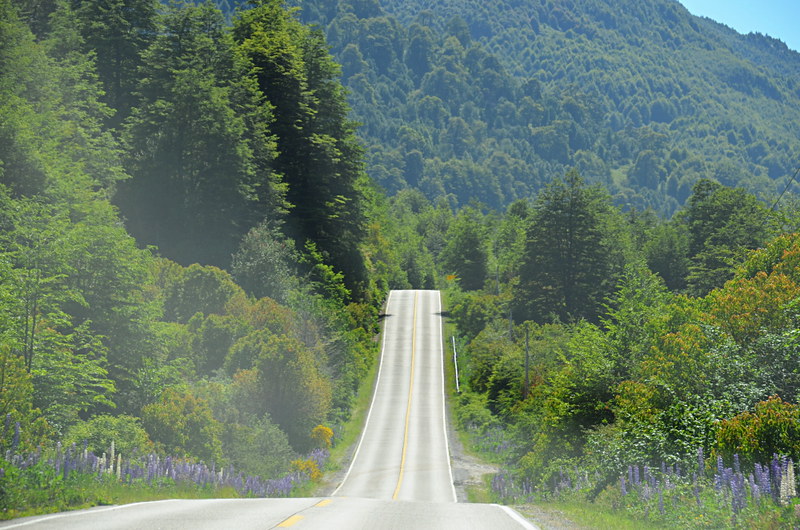
Chile’s Carretera Austral sounds like it’s going to be a wild beast.
Stocked up with energy bars, water, chocolate, crisps, sandwiches, craft beers and wine we set off on our first main test, driving 200km from Coyhaique to Quelat. Only 26km of this section is unpaved, so it sounds like a relatively gentle introduction.
In new locations Andy drives, I navigate. It’s a system which works well for us. Without going into detail, the other way around really doesn’t. It’s unlikely the Carretera Austral will test my map reading skills. Only one road comes into Coyhaique on one side of the town and only one leaves on the other.

As we depart Coyhaique, the road is empty, the scenery epic. Big country epic. We stop at a viewpoint to take in an immense landscape where gentle patchwork fields roll to the base of granite plateaus whilst jagged snowy peaks add a hazy backdrop. This canvas consisting of the wild and the tamed accompanies us as we travel north. We cruise past long lakes, dense forests and field-sized swathes of lavender lupins, a rampant invader albeit an exceedingly pretty one.
Our car is a Mitsubishi pick-up, a monster which seems perfect for tackling a road which growls and snaps at tyres like a bored mongrel in a sleepy town. It eats up this ‘paved’ part of the Austral easily, allowing Andy time to get to grips with her metal steed before we hit the switchbacks, loose gravel and pothole minefields.
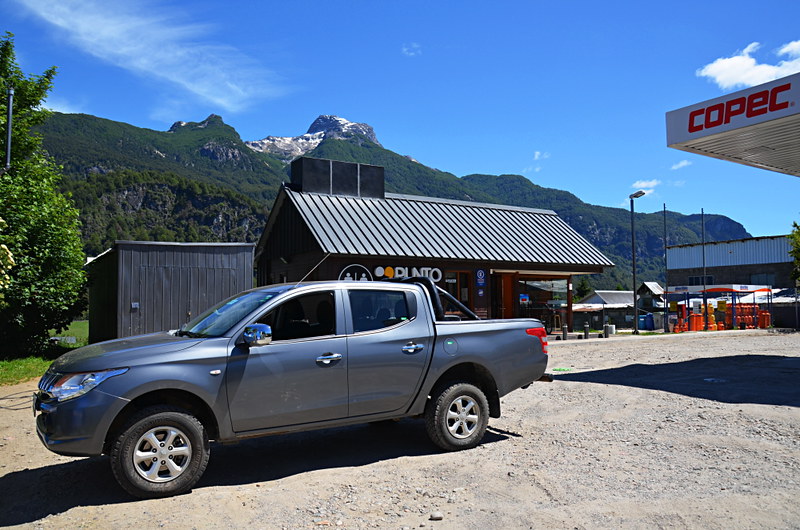
At Villa Mañihuales we do as advised and fill up with diesel. It’s a town of low clapperboard houses, in truth more village than town, but it has the only petrol station for over 200km. A field adjacent to the petrol station is full of beautiful golden birds with long curved beaks and cartoon calls, bandurrias (buff-necked ibis). Everything seems unfamiliar and exotic.
From Villa Mañihuales the countryside changes, the land less farmed by man, the tree-covered hills steeper and tighter together, the snowy peaks closer.
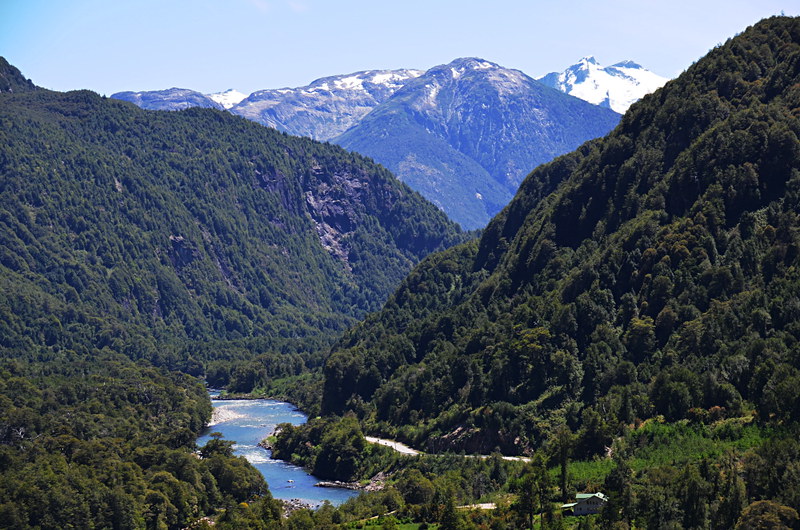
172km into the drive the tarmac stops with an abrupt bump. It’s replaced by an uneven surface of loose white stones which make the wheels spin and the car slide. Our purring metal amigo becomes a rebellious stallion as we climb up and up through a series of switchbacks. Switching the car to full on 4×4 helps tame it a bit, but the pick-up still threatens to buck if not kept on a tight leash.
It’s only 4 kilometres till we pull into the rough parking lot at the Bosque Encantado (Enchanted Forest), a long 4km. As well as having a slippery surface to deal with, roadworks on sections of the Carretera Austral mean parts are closed for hours on end. As it’s the only road through most of Chile you either plan to get through these sections before the road closes, or you find something to do until it opens again. Between us and our goal, 22km further on, the road shuts between 1 and 5pm. There’s no way we’re going to put the pedal to the metal on a road like this, instead we plan to spend the time exploring the Bosque Encantado.
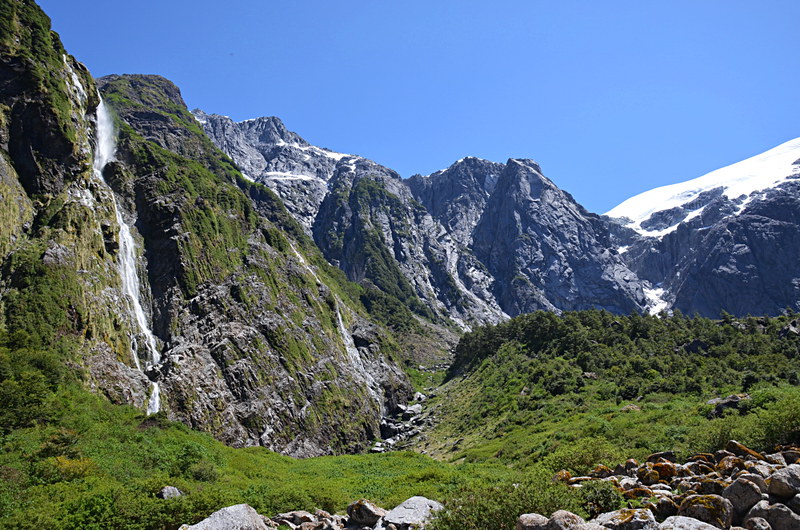
It’s 5000 Pesos (approximately 7 Euros) per person to enter the Bosque Encantado. A path winds easily through a jungle of a forest and across glinting streams. A choir of unseen birds sing elaborate and jaunty songs as we stroll through the dappled woods before climbing higher and higher, sweating in the early summer sunshine. As we ascend, the birdsong is drowned by the roar of rushing water, the sound of something big. The continuous gushing teases us for longer than we expect before eventually we break free from the canopy into an open cauldron and scenes which act like hitting the emergency break. Straight ahead, literally looking like the icing on the cake, is a blindingly white glacier filling a saddle between two granite peaks. Off to one side is a tall, elegant waterfall. It is one of the most beautiful spots I’ve ever set eyes upon.
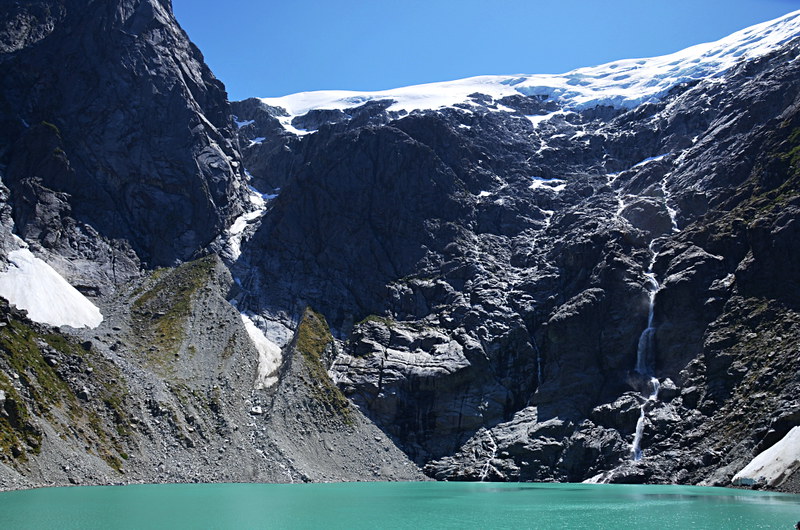
Between us and the onward path is a lively stream. There are plenty of boulders, so finding a route across without ending up with wet feet is easy enough. The path climbs again, rising toward the foot of the glacier. As we drag ourselves over a final ridge we’re met with a vision which surpasses the one we saw after emerging from the forest – a milky blue glacial lake hidden by the undulating landscape until the very last moment. The forest might be enchanted, the lake is fantastical.
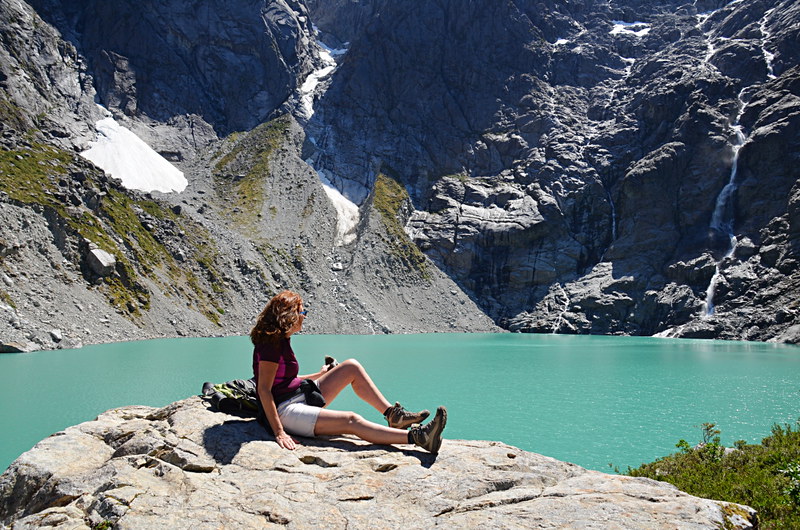
It’s easy to lose a couple of hours, snacking and fawning over the scenery before it’s time to take to the road again. It’s just after 5pm and the Austral is open for business.
We congratulate ourselves on our perfect timing. This smugness lasts for about 5 minutes. The quiet road has become the busy road; a convoy of trucks timing their arrival with the road reopening. The trucks throw up thick dust clouds which envelope everything, creating an impenetrable cloak making progress slow and treacherous.

For 22 kilometres we crawl and curse the dust monsters, our nerves in shreds as we try to blindly maintain a line which will keep us on the narrow road and not in a ditch. We only pause from bitching when we pass cyclists. The dust must be a nightmare for them. At least cocooned in our cabin we don’t have to breathe it in.
Finally we reach our turn-off, a track leading to Posada Quelat, and within moments we swap the fog for a verdant oasis, a tranquil paradise where we’ll spend the next couple of days.

The last 22km have been exhausting.
The craft beer in our ‘survival pack’ turns out to be an essential item. With thirsty relief we enthusiastically toast our first proper introduction to the Carretera Austral.
Jack is co-editor, writer and photographer for BuzzTrips and the Real Tenerife series of travel websites as well as a contributor to online travel sites and travel magazines. Follow Jack on Google+




Be the first to comment